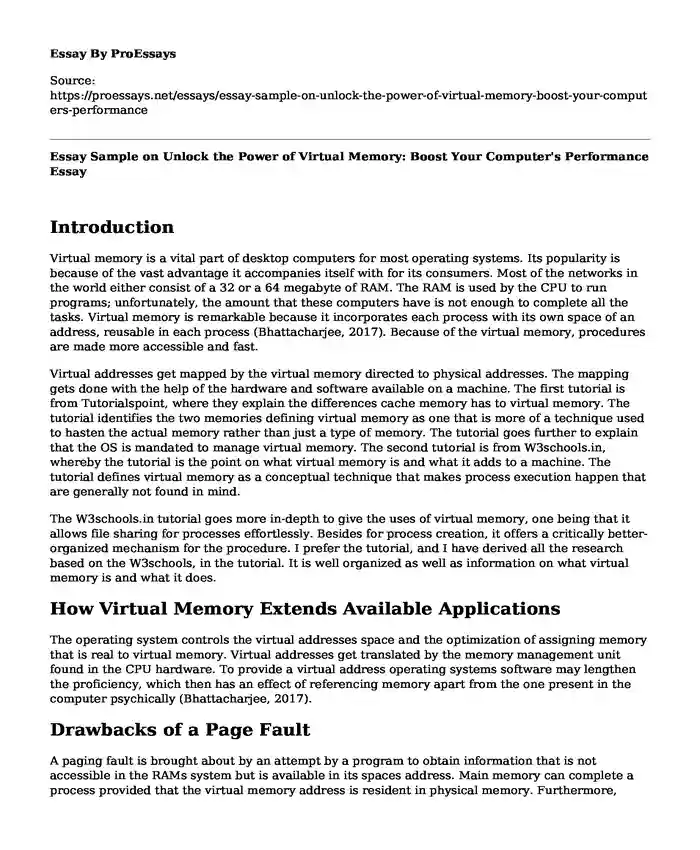Introduction
Virtual memory is a vital part of desktop computers for most operating systems. Its popularity is because of the vast advantage it accompanies itself with for its consumers. Most of the networks in the world either consist of a 32 or a 64 megabyte of RAM. The RAM is used by the CPU to run programs; unfortunately, the amount that these computers have is not enough to complete all the tasks. Virtual memory is remarkable because it incorporates each process with its own space of an address, reusable in each process (Bhattacharjee, 2017). Because of the virtual memory, procedures are made more accessible and fast.
Virtual addresses get mapped by the virtual memory directed to physical addresses. The mapping gets done with the help of the hardware and software available on a machine. The first tutorial is from Tutorialspoint, where they explain the differences cache memory has to virtual memory. The tutorial identifies the two memories defining virtual memory as one that is more of a technique used to hasten the actual memory rather than just a type of memory. The tutorial goes further to explain that the OS is mandated to manage virtual memory. The second tutorial is from W3schools.in, whereby the tutorial is the point on what virtual memory is and what it adds to a machine. The tutorial defines virtual memory as a conceptual technique that makes process execution happen that are generally not found in mind.
The W3schools.in tutorial goes more in-depth to give the uses of virtual memory, one being that it allows file sharing for processes effortlessly. Besides for process creation, it offers a critically better-organized mechanism for the procedure. I prefer the tutorial, and I have derived all the research based on the W3schools, in the tutorial. It is well organized as well as information on what virtual memory is and what it does.
How Virtual Memory Extends Available Applications
The operating system controls the virtual addresses space and the optimization of assigning memory that is real to virtual memory. Virtual addresses get translated by the memory management unit found in the CPU hardware. To provide a virtual address operating systems software may lengthen the proficiency, which then has an effect of referencing memory apart from the one present in the computer psychically (Bhattacharjee, 2017).
Drawbacks of a Page Fault
A paging fault is brought about by an attempt by a program to obtain information that is not accessible in the RAMs system but is available in its spaces address. Main memory can complete a process provided that the virtual memory address is resident in physical memory. Furthermore, MMU signals a page fault exception given an instance where the virtual memory is note resident making a need for the CPU to divert implementation to codes that are specially called a page fault.
Thirdly the OS identifies the page fault and determines the type of virtual page that is required. The system also checks to determine the validity of addresses and also determines whether there are no access program protections once the page address fault gets discovered. If, for instance, the virtual address gets verified, the OS receives mandated to determine the page frame's availability. Algorithms get replaced, given the fact that no frames are free to do away with a page.
Benefits of Virtual Memory
There are numerous advantages of virtual memory firstly it aids in the gaining of the speed of programs to be executed. Secondly, for multiprogramming, it comes quite in hand. It also makes running of numerous applications smooth at once. It also helps one to fit into smaller programs many large ones. It also comes with the advantage of sharing between memories common data or codes.
Conclusion
One point about virtual memory that got my attention is that when used, it tends to slow down computers for the mapping of data in physical memory and virtual. The mapping requires more support from the hardware for translation of addressed. In its advantages, virtual memory does it aids in the gaining of the speed of programs to be executed by also making the smooth running of numerous applications possible. To grasp the idea behind all that are vividly utilizing the resources at hand to master all the areas that had issues in clearly defining virtual memory.
References
Bhattacharjee, A (2017). Architectural and Operating System Support for Virtual Memory. Morgan & Claypool Publishers. p. 1. ISBN 9781627056021. Retrieved October 16, 2017
Cite this page
Essay Sample on Unlock the Power of Virtual Memory: Boost Your Computer's Performance. (2023, Sep 25). Retrieved from https://proessays.net/essays/essay-sample-on-unlock-the-power-of-virtual-memory-boost-your-computers-performance
If you are the original author of this essay and no longer wish to have it published on the ProEssays website, please click below to request its removal:
- The Anonymity of Data Essay
- Depression and Smartphones: Annotated Bibliography
- Essay Sample on Cybersecurity Threats and Vulnerable Assets
- Essay Example on Unlimited Possibilities: The Cell Phone Revolution
- Essay Example on Protecting Patient Data: The Persistent Challenge of Data Breaches
- Project Management in Energy Industry: Streamlining Departments - Free Essay Example
- The iPhone Marketing - Report Sample







